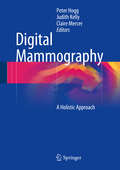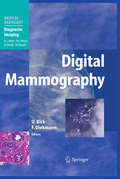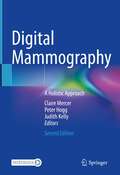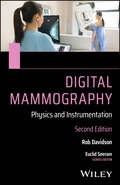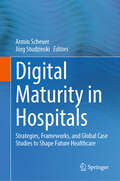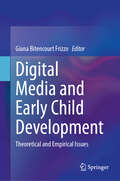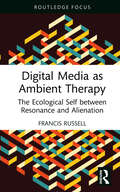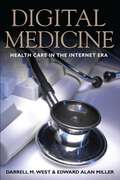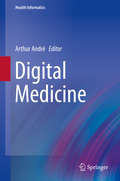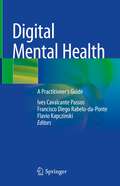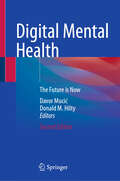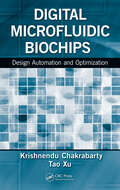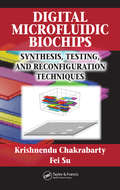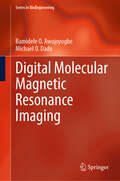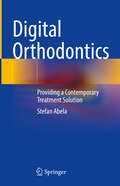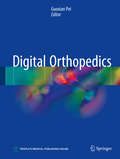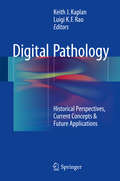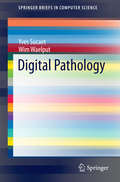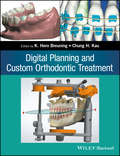- Table View
- List View
Digital Instrumentation and Control Systems in Nuclear Power Plants: Safety and Reliability Issues
by Committee on Application of Digital InstrumentationThe nuclear industry and the U.S. Nuclear Regulatory Commission (USNRC) have been working for several years on the development of an adequate process to guide the replacement of aging analog monitoring and control instrumentation in nuclear power plants with modern digital instrumentation without introducing off-setting safety problems. This book identifies criteria for the USNRC's review and acceptance of digital applications in nuclear power plants. It focuses on eight areas: software quality assurance, common-mode software failure potential, systems aspects of digital instrumentation and control technology, human factors and human-machine interfaces, safety and reliability assessment methods, dedication of commercial off-the-shelf hardware and software, the case-by-case licensing process, and the adequacy of technical infrastructure.
Digital Mammography
by Peter Hogg Judith Kelly Claire MercerThis book offers a single publication to be utilised comprehensively as a reference manual within current mammographic clinical practice for use by assistant practitioners and practitioners as well as trainees in radiography and related disciplines. In recent years mammographic clinical practice and technology have evolved rapidly and become increasingly sophisticated, this book will cover these issues. The public feel increasingly empowered to 'have a say' in their care and expectations of their mammography experience is high. Consequently a well-trained, well-informed practitioner is of paramount importance in clinical practice today. This book addresses patient/client-related issues in the form of psychological and emotional support they may require. This will enable the reader to gain insight into the patient/client perspective and thereby assist in meeting their needs.
Digital Mammography
by Felix Diekmann Ulrich BickThis state-of-the-art reference book provides in-depth coverage of all aspects of digital mammography, including detector technology, image processing, computer-aided diagnosis, soft-copy reading, digital workflow, and PACS. Specific advantages and disadvantages of digital mammography in comparison to screen-film mammography are thoroughly discussed. By including authors from both North America and Europe, the book is able to outline variations in the use, acceptance, and quality assurance of digital mammography between the different countries and screening programs. Advanced imaging techniques and future developments such as contrast mammography and digital breast tomosynthesis are also covered in detail. All of the chapters are written by internationally recognized experts and contain numerous high-quality illustrations. This book will be of great interest both to clinicians who already use or are transitioning to digital mammography and to basic scientists working in the field.
Digital Mammography: A Holistic Approach
by Peter Hogg Judith Kelly Claire MercerThis heavily revised second edition is a practically focused textbook focusing on how to successfully utilise mammography-related techniques. It covers a wide range of topics related to holistic mammographic imaging reflecting the emerging digital and artificial imaging technology. Furthermore, new chapters provide clear practical focused guidance on how to provide psychological and emotional support to both clients and colleagues, and the support of persons with dementia.Digital Mammography: A Holistic Approach is a concise textbook covering the latest techniques that can be applied in this field. Therefore, it is of significant interest to radiographers, technicians, technologists, physicists, and nurses seeking to improve their understanding of these techniques. Additional questions via app: Download the Springer Nature Flashcards app for free and use exclusive additional material to test your knowledge.
Digital Mammography: A Practical Approach
by Gary J. Whitman Tamara Miner HaygoodDigital mammography has many advantages over film-screen mammography, including faster acquisition, easier storage and easier retrieval of images. Written by expert radiologists and physicists, Digital Mammography: A Practical Approach compares digital mammography to conventional film-screen mammography, reviews clinical cases and explores newer modalities. Key topics include: • Digital detectors • Monitors • Image acquisition • Image storage, retrieval and transfer • Image interpretation and efficacy • Artifacts • A comparison of commercially available systems • Mobile digital mammography. An image atlas and sections on digital tomosynthesis and computed tomography of the breast enhance the text. Digital Mammography: A Practical Approach melds the worlds of clinical radiology and physics in an easy-to-understand, practical resource. A valuable addition to the shelf of radiologists, radiologic technicians, practising medical physicists and mammography technologists; and any practitioners developing and expanding digital mammography programs.
Digital Mammography: Physics and Instrumentation
by Rob DavidsonAn authoritative and up-to-date discussion of digital mammography fundamentals The newly revised second edition of Digital Mammography: Physics and Instrumentation delivers an expert discussion of all things digital mammography. From an explanation of how mammography plays an important role in cancer detection and treatment to practical discussions of mammography image formation, you’ll find analysis of the most recent advances in digital breast tomosynthesis and photon counting mammography. Readers will also discover: Complete treatments of mammographic instrumentation and physicsA thorough introduction to image quality optimization techniquesComprehensive explorations of new artificial intelligence applications in mammographyValuable information about how radiation dose is relevant to patient safety and diagnostics Perfect for mammography radiologic technologists and diagnostic radiographers, Digital Mammography: Physics and Instrumentation will also benefit breast clinicians, trainee radiologists, and students of medical imaging and radiography.
Digital Maturity in Hospitals: Strategies, Frameworks, and Global Case Studies to Shape Future Healthcare
by Armin Scheuer Jörg StudzinskiThis book serves as a comprehensive guide for hospitals embarking on a digital maturity journey, offering actionable insights, best practices, and lessons learned from healthcare leaders worldwide. It brings together contributions from over 50 world-renowned digital health experts, providing hospitals with the tools and strategies needed to successfully drive digital transformation to benefit both healthcare workers and patients. Covering a broad range of topics, the chapters delve into critical dimensions of hospital digitalization, including digital maturity models, IT capability, interoperability, governance, patient-centered care, and advanced data analytics. Readers will find real-world case studies showcasing hospitals and governmental initiatives that have achieved externally validated success in their digital transformation efforts. As emphasized in the Foreword written by the President of the International Diabetes Federation, the book highlights the impact of digital maturity on patient care and explores forward-looking trends that will shape the future of healthcare digitalization, such as green IT, ethical considerations, social determinants of health, and workforce development. Whether you are a healthcare leader, policy maker, or practitioner, this book offers valuable guidance and strategic insights to help you navigate your organization’s digital maturity journey and drive excellence in healthcare delivery.
Digital Media and Early Child Development: Theoretical and Empirical Issues
by Giana Bitencourt FrizzoThis book analyzes how the use of digital media by young children can affect their development. Children are starting to use digital media at an earlier age and this use is increasing. With the adoption of technology moving so quickly, research in the area also needs to evolve, and new theoretical and methodological approaches are needed. This book aims to contribute to this field of study by presenting new theoretical frameworks and methodological approaches to help advance research; by discussing results of empirical studies carried out with young children and their caregivers; and by proposing possible interventions to help parents and caregivers better oversee their children’s digital media use. Chapters in this volume are divided into five parts. The first part is dedicated to discussing theoretical and methodological issues involved in the study of digital media use by young children. The second part presents empirical studies that investigate the potential impacts of digital media use in child development. The third part brings together studies analyzing digital media use and early child development during the COVID-19 pandemic. Chapters in the fourth part analyze how digital media use affects parenthood. And the fifth and final part presents proposals of educational interventions to help parents and caregivers oversee their young children’s digital media consumption. Digital Media and Early Child Development: Theoretical and Empirical Issues will be of interest to different kinds of researchers and practitioners working with child, family and media studies. Researchers in the fields of developmental psychology and media studies will find innovative theoretical and methodological proposals to study how young children interact with digital media. While child and family psychologists, social workers and pediatricians will find useful information to understand when digital media use can cause problems to children and their families.
Digital Media as Ambient Therapy: The Ecological Self between Resonance and Alienation (Routledge Studies in New Media and Cyberculture)
by Francis RussellDigital Media as Ambient Therapy explores the ways “mental illness” can emerge from our relationships (with ourselves, others, and the world), to address the concern around what kind of relationality is conducive for “mental health” and what role digital technologies can play in fostering such relationality.Exploring the rise of ambient—that is to say, ubiquitous, surrounding, and environmental—technologies and their impact on our understanding of “mental health,” sanity, and therapy, this book critically examines the work of influential contemporary social theorists such as Hartmut Rosa and investigates case studies that reveal new modes of digitally mediated intimacy and attention, such as ASMR and QAnon. It also poses the question of what “mental health” and “mental illness” mean for subjects increasingly faced with a maddening sense of interconnectedness.This book offers new perspectives for academics and postgraduates interested in critical discussions of alienation, digital technology, and contemporary social theory.
Digital Medicine
by Darrell M. West Edward Alan MillerInformation technology has dramatically changed our lives in areas ranging from commerce and entertainment to voting. Now, policy advocates and government officials hope to bring the benefits of enhanced information technology to health care. Already, consumers can access a tremendous amount of medical information online. Some physicians encourage patients to use email or web messaging to manage simple medical issues. Increasingly, health care products can be purchased electronically.Yet the promise of e-health remains largely unfulfilled. Digital Medicine investigates the factors limiting digital technology's ability to remake health care. It explores the political, social, and ethical challenges presented by online health care, as well as the impact that racial, ethnic, and other disparities are having on the e-health revolution. It examines the accessibility of health-related websites for different populations and asks how we can close access gaps and ensure the reliability and trustworthiness of the information presented online. Darrell West and Edward Miller use multiple sources, including original survey research and website analysis, to study the content, sponsorship status, and public usage of health care-related websites, as well as the relationship between e-health utilization and attitudes about health care in the United States. They also explore the use of health information technology in other countries. The result is an important contribution to our understanding of health information innovation in America and around the world.
Digital Medicine
by Darrell M. West Edward Alan MillerInformation technology has dramatically changed our lives in areas ranging from commerce and entertainment to voting. Now, policy advocates and government officials hope to bring the benefits of enhanced information technology to health care. Already, consumers can access a tremendous amount of medical information online. Some physicians encourage patients to use email or web messaging to manage simple medical issues. Increasingly, health care products can be purchased electronically.Yet the promise of e-health remains largely unfulfilled. Digital Medicine investigates the factors limiting digital technology's ability to remake health care. It explores the political, social, and ethical challenges presented by online health care, as well as the impact that racial, ethnic, and other disparities are having on the e-health revolution. It examines the accessibility of health-related websites for different populations and asks how we can close access gaps and ensure the reliability and trustworthiness of the information presented online.Darrell West and Edward Miller use multiple sources, including original survey research and website analysis, to study the content, sponsorship status, and public usage of health care-related websites, as well as the relationship between e-health utilization and attitudes about health care in the United States. They also explore the use of health information technology in other countries. The result is an important contribution to our understanding of health information innovation in America and around the world.
Digital Medicine (Health Informatics)
by Arthur André<p>This book provides an up to date user friendly resource on the emerging field of digital medicine and its present and potential future role in modern healthcare. Chapters are written by a specialist on each area in an easy to read format, which broadly covers the potential of digital medicine in epidemiology, precision medicine and surgery. Chapters focus on aspects of telemedicine, the applications of big data, artificial intelligence, blockchain, regenerative medicine, legal aspects and business models. Furthermore, guidance is given on medical ethics and how to manage doctor patient relationships in the modern age. <p>Digital Medicine comprehensively reviews the emerging field of digital medicine in modern healthcare and is therefore a critical resource for physicians and medical trainees who are looking for comprehensive resource on digital medicine and its potential role in modern healthcare.</p>
Digital Mental Health: A Practitioner's Guide
by Ives Cavalcante Passos Francisco Diego Rabelo-da-Ponte Flavio KapczinskiThis innovative book focuses on potential, limitations, and recommendations for the digital mental health landscape. Authors synthesize existing literature on the validity of digital health technologies, including smartphones apps, sensors, chatbots and telepsychiatry for mental health disorders. They also note that collecting real-time biological information is usually better than just collect filled-in forms, and that will also mitigate problems related to recall bias in clinical appointments. Limitations such as confidentiality, engagement and retention rates are moreover discussed. Presented in fifteen chapters, the work addresses the following questions: may smartphones and sensors provide more accurate information about patients’ symptoms between clinical appointments, which in turn avoid recall bias? Is there evidence that digital phenotyping could help in clinical decisions in mental health? Is there scientific evidence to support the use of mobile interventions in mental health? Digital Mental Health will help clinicians and researchers, especially psychiatrists and psychologists, to define measures and to determine how to test apps or usefulness, feasibility and efficacy in order to develop a consensus about reliability. These professionals will be armed with the latest evidence as well as prepared to a new age of mental health.
Digital Mental Health: The Future is Now
by Donald M. Hilty Davor MucićThe previous 2016 edition, "E-Mental Health," shed light on the application of telecommunications technologies to deliver mental health services remotely to people in often underserved locations due to geographic distance, and cultural or language differences. This new edition on "Digital mental health" represents a similar concept as e-mental health. However, the paradigm has changed; underserved populations are no longer the exclusive focus. The experience of the COVID-19 pandemic has encouraged wider acceptance and application of the technology, expanding its use to both rural and urban areas. The expansive potential of digital mental health approaches is demonstrated in a variety of mental health contexts, highlighted through clinical examples and applications that introduce innovative strategies for technology integration. Moreover, the book outlines a framework for global cooperation, with the goal of cross-border exchange of expertise and knowledge. This book targets a broad audience, including mental health practitioners, medical and nursing students, academic researchers, technology experts, and health policymakers.
Digital Microfluidic Biochips: Design Automation and Optimization
by Krishnendu Chakrabarty Tao XuMicrofluidics-based biochips combine electronics with biochemistry, providing access to new application areas in a wide variety of fields. Continued technological innovations are essential to assuring the future role of these chips in functional diversification in biotech, pharmaceuticals, and other industries.Revolutionary guidance on design, opti
Digital Microfluidic Biochips: Synthesis, Testing, and Reconfiguration Techniques
by Krishnendu Chakrabarty Fei SuDigital Microfluidic Biochips focuses on the automated design and production of microfluidic-based biochips for large-scale bioassays and safety-critical applications. Bridging areas of electronic design automation with microfluidic biochip research, the authors present a system-level design automation framework that addresses key issues in the design, analysis, and testing of digital microfluidic biochips. The book describes a new generation of microfluidic biochips with more complex designs that offer dynamic reconfigurability, system scalability, system integration, and defect tolerance. Part I describes a unified design methodology that targets design optimization under resource constraints. Part II investigates cost-effective testing techniques for digital microfluidic biochips that include test resource optimization and fault detection while running normal bioassays. Part III focuses on different reconfiguration-based defect tolerance techniques designed to increase the yield and dependability of digital microfluidic biochips. Expanding upon results from ongoing research on CAD for biochips at Duke University, this book presents new design methodologies that address some of the limitations in current full-custom design techniques. Digital Microfluidic Biochips is an essential resource for achieving the integration of microfluidic components in the next generation of system-on-chip and system-in-package designs.
Digital Molecular Magnetic Resonance Imaging (Series in BioEngineering)
by Michael O. Dada Bamidele O. AwojoyogbeThis book pushes the limits of conventional MRI visualization methods by completely changing the medical imaging landscape and leads to innovations that will help patients and healthcare providers alike. It enhances the capabilities of MRI anatomical visualization to a level that has never before been possible for researchers and clinicians. The computational and digital algorithms developed can enable a more thorough understanding of the intricate structures found within the human body, surpassing the constraints of traditional 2D methods. The Physics-informed Neural Networks as presented can enhance three-dimensional rendering for deeper understanding of the spatial relationships and subtle abnormalities of anatomical features and sets the stage for upcoming advancements that could impact a wider range of digital heath modalities. This book opens the door to ultra-powerful digital molecular MRI powered by quantum computing that can perform calculations that would take supercomputers millions of years.
Digital Nursing: Shaping Practice and Identity in the Age of Informatics
by Matthew WynnInvestigating the ways in which digital technology is transforming the roles of nurses and how they deliver care, this book explores how nurses can optimise patient care, enhance clinical decision-making, and improve healthcare outcomes in the information age.The first half of the book emphasises the importance of nursing theory in guiding nursing practice and decision-making in the context of digital healthcare. Examining how technology is transforming their responsibilities and skillsets, it showcases the opportunities and challenges that nurses encounter in embracing digital tools to optimise patient care. Some of the thorniest challenges relate to ethical considerations, and an international selection of contributors discuss some of the key dilemmas and provide strategies for navigating the ethical dimensions of digital nursing. The second half of the book focuses on three case studies – using social media, wound care, and infection control. These chapters look at how digital technology is transforming specific aspects of nursing practice, providing concrete examples of the impact of technology on patient care and nursing efficiency. The book concludes with a discussion of emerging technologies and their potential implications for nursing practice, patient care, and healthcare delivery.This text is a valuable resource for students, practitioners, and educators interested in how new technologies are integrated into nursing theory and practice, and the implications for person-centred humanistic care.
Digital Orthodontics: Providing a Contemporary Treatment Solution
by Stefan AbelaThis book is a comprehensive and detailed overview of the most contemporary techniques in orthodontics. It will help readers to understand complex software systems, software integrations and the equipment needed to deliver the latest techniques to patients undergoing orthodontic treatment. The book has been written in an easy-to-understand way and includes numerous flow diagrams and images of software programs and equipment in order to facilitate the understanding of modern systems. The first part of the book explains basic concepts and materials including CAD-CAM and 3D designs and explains the processes involved to deliver a fully digitised orthodontic treatment pathway. The chapters in the second section provide an excellent projection of what the future holds for the profession and the specialism discussing relevant Apps and artificial intelligence. This book will be helpful for dental final year undergraduates, postgraduates and all practising dental surgeons andorthodontic specialists, who would like to render their workflows more contemporary and acquire knowledge on the latest innovations that they can deliver to their clients.
Digital Orthopedics
by Guoxian PeiThis book addresses all aspects of digital techniques in orthopedics, from development of the core principles to imaging techniques, computer-aided design, reverse engineering and their applications. It illustrates the successful applications in accurate operation using 3-D reconstruction and applied digital techniques. All illustrations and tables were meticulously selected and are easy to understand. The book was written for all doctors and researchers who work in the fields of orthopedics, CAD/CAM and anatomy. Above all, surgeons, physiatrists, radiologists, and engineers in image processing and orthopedics will find it a valuable resource.
Digital Pathology
by Keith J. Kaplan Luigi K. F. RaoDigital Pathology: Historical Perspectives, Current Concepts & Future Applications provides the authoritative text in the digital pathology domain by combining the established expertise of leaders in this diverse arena with practical applications of this transformative platform while harnessing a content rich, interactive format. In detailing a cohesive narrative from a broad, global perspective the lessons learned from the past, the obstacles to digital pathology adoption that have been overcome and the challenges that remain for full realization of the potential that computational analysis affords, this text provides readers with the latest in where the field is heading as it seeks to unlock the potential of digital pathology by leveraging cutting edge technologies and innovative tools. Digital Pathology: Historical Perspectives, Current Concepts & Future Applications will be of great value to Pathologists including Translational Researchers and Informaticists, Pathology Trainees including Residents and Informatics Fellows, Healthcare CMIOs and CIOs, Bioimaging Engineers and Computer Vision Scientists, as well as Laboratory Information Technologists.
Digital Pathology
by Yves Sucaet Wim WaelputDigital pathology has experienced exponential growth, in terms of its technology and applications, since its inception just over a decade ago. Though it has yet to be approved for primary diagnostics, its values as a teaching tool, facilitator of second opinions and quality assurance reviews and research are becoming, if not already, undeniable. It also offers the hope of providing pathology consultant and educational services to under-served areas, including regions of the world that could not possibly sustain this level of services otherwise. And this is just the beginning, as its adoption by the also rapidly-emerging fields of medical systems biology and 3D tissue imaging indicate. This work describes how digital pathology not only has the potential to dramatically impact medical education and the delivery of health care, but also to exert an immensely positive influence worldwide, including in countries and regions that normally fail to benefit from such technological advances.
Digital Phenotyping and Mobile Sensing: New Developments in Psychoinformatics (Studies in Neuroscience, Psychology and Behavioral Economics)
by Christian Montag Harald BaumeisterThis book offers a snapshot of cutting-edge applications of mobile sensing for digital phenotyping in the field of Psychoinformatics. The respective chapters, written by authoritative researchers, cover various aspects related to the use of these technologies in health, education, and cognitive science research. They share insights both into established applications of mobile sensing (such as predicting personality or mental and behavioral health on the basis of smartphone usage patterns) and emerging trends. Machine learning and deep learning approaches are discussed, and important considerations regarding privacy risks and ethical issues are assessed. In addition to essential background information on various technologies and theoretical methods, the book also presents relevant case studies and good scientific practices, thus addressing researchers and professionals alike. To cite Thomas R. Insel, who wrote the foreword to this book: “Patients will only use digital phenotyping if it solves a problem, perhaps a digital smoke alarm that can prevent a crisis. Providers will only use digital phenotyping if it fits seamlessly into their crowded workflow. If we can earn public trust, there is every reason to be excited about this new field. Suddenly, studying human behavior at scale, over months and years, is feasible.”
Digital Phenotyping and Mobile Sensing: New Developments in Psychoinformatics (Studies in Neuroscience, Psychology and Behavioral Economics)
by Christian Montag Harald BaumeisterThis book offers a snapshot of cutting-edge applications of digital phenotyping and mobile sensing for studying human behavior and planning innovative e-healthcare interventions. The respective chapters, written by authoritative researchers, cover both theoretical perspectives and good scientific and professional practices related to the use and development of these technologies. They share novel insights into established applications of mobile sensing, such as predicting personality or mental and behavioral health on the basis of smartphone usage patterns, and highlight emerging trends, such as the use of machine learning, big data and deep learning approaches, and the combination of mobile sensing with AI and expert systems. Important issues relating to privacy and ethics are analyzed, together with selected case studies. This thoroughly revised and extended second edition provides researchers and professionals with extensive information on the latest developments in the field of digital phenotyping and mobile sensing. It gives a special emphasis to trends in diagnostics systems and AI applications, suggesting important future directions for research in public health and social sciences.
Digital Planning and Custom Orthodontic Treatment
by Chung H. Kau K. Hero BreuningDigital Planning and Custom Orthodontic Treatment offers a thorough overview of digital treatment planning as it relates to custom orthodontic treatment. Covers 3D imaging of the dentition and the face with intraoral scanners, CBCT machines, and 3D facial scanners Provides a complete guide to using digital treatment planning to improve the predictability, efficiency, and efficacy of orthodontic treatment Discusses CAD/CAM fabrication of appliances and the monitoring of treatment progress and stability Offers detailed descriptions for the main commercial systems on the market Presents clinically oriented information to aid in yielding high quality and stable results

